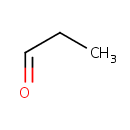|
Record Information |
|---|
| Version |
1.0 |
|---|
| Update Date |
1/22/2018 11:54:54 AM |
|---|
|
Metabolite ID | PAMDB001684 |
|---|
|
Identification |
|---|
| Name: |
Propanal |
|---|
| Description: | Propanal or propionaldehyde is the aldehyde of the 3 carbon propyl group. It has a chemical formula of CH3CH2CHO, and is a structural isomer of propanone. At room temperature, it is a colourless liquid with a slightly irritating, fruity odour.; It is principally used as a precursor to trimethylolethane (CH3C(CH2OH)3) through a condensation reaction with formaldehyde; this triol is an important intermediate in the production of alkyd resins. Other applications include reduction to propanol and oxidation to propionic acid. |
|---|
|
Structure |
|
|---|
| Synonyms: | - 1-Propanal
- 1-Propanone
- Aldehyde propionique
- C2H5CHO
- Methylacetaldehyde
- N-Propanal
- N-Propionaldehyde
- Propaldehyde
- Propanal
- Propanalaldehyde
- Propanaldehyde
- Propional
- Propionaldehyde
- Propionic aldehyde
- Proprionaldehyde
- Propyl aldehyde
- Propylaldehyde
- Propylic aldehyde
|
|---|
|
Chemical Formula: |
C3H6O |
|---|
| Average Molecular Weight: |
58.0791 |
|---|
| Monoisotopic Molecular
Weight: |
58.041864814 |
|---|
| InChI Key: |
NBBJYMSMWIIQGU-UHFFFAOYSA-N |
|---|
| InChI: | InChI=1S/C3H6O/c1-2-3-4/h3H,2H2,1H3 |
|---|
| CAS
number: |
123-38-6 |
|---|
| IUPAC Name: | propanal |
|---|
|
Traditional IUPAC Name: |
propionaldehyde |
|---|
| SMILES: | CCC=O |
|---|
|
Chemical Taxonomy |
|---|
|
Taxonomy Description | This compound belongs to the class of organic compounds known as alpha-hydrogen aldehydes. These are aldehydes with the general formula HC(H)(R)C(=O)H, where R is an organyl group. |
|---|
|
Kingdom |
Organic compounds |
|---|
| Super Class | Organooxygen compounds |
|---|
|
Class |
Carbonyl compounds |
|---|
| Sub Class | Aldehydes |
|---|
|
Direct Parent |
Alpha-hydrogen aldehydes |
|---|
| Alternative Parents |
|
|---|
| Substituents |
- Alpha-hydrogen aldehyde
- Hydrocarbon derivative
- Short-chain aldehyde
- Aliphatic acyclic compound
|
|---|
| Molecular Framework |
Aliphatic acyclic compounds |
|---|
| External Descriptors |
|
|---|
|
Physical Properties |
|---|
| State: |
Liquid |
|---|
| Charge: | 0 |
|---|
|
Melting point: |
-80 °C |
|---|
| Experimental Properties: |
| Property | Value | Source |
|---|
| Water Solubility: | 306 mg/mL at 25 deg C | PhysProp | | LogP: | 0.59; 0.59 [HANSCH,C ET AL. (1995)] | PhysProp |
|
|---|
| Predicted Properties |
|
|---|
|
Biological Properties |
|---|
| Cellular Locations: |
Cytoplasm |
|---|
| Reactions: | |
|---|
|
Pathways: |
Not Available |
|---|
|
Spectra |
|---|
| Spectra: |
| Spectrum Type | Description | Splash Key | |
|---|
| GC-MS | GC-MS Spectrum - GC-MS | Not Available |
|---|
| LC-MS/MS | LC-MS/MS Spectrum - Quattro_QQQ 10V, Positive (Annotated) | splash10-0a4i-9000000000-addcd7ef3249da0c3006 | View in MoNA |
|---|
| LC-MS/MS | LC-MS/MS Spectrum - Quattro_QQQ 25V, Positive (Annotated) | splash10-052f-9000000000-b7cab81070aff00497c6 | View in MoNA |
|---|
| LC-MS/MS | LC-MS/MS Spectrum - Quattro_QQQ 40V, Positive (Annotated) | splash10-0a4l-9000000000-e9e60e8897ba5a8e14ee | View in MoNA |
|---|
| LC-MS/MS | LC-MS/MS Spectrum - EI-B (HITACHI RMU-6M) , Positive | splash10-057i-9000000000-52017f5345efcb7c9e18 | View in MoNA |
|---|
| Predicted LC-MS/MS | Predicted LC-MS/MS Spectrum - 10V, Positive | splash10-0a4i-9000000000-971c212b11d2cbddac7d | View in MoNA |
|---|
| Predicted LC-MS/MS | Predicted LC-MS/MS Spectrum - 20V, Positive | splash10-0a4l-9000000000-86839cd4133b824334ac | View in MoNA |
|---|
| Predicted LC-MS/MS | Predicted LC-MS/MS Spectrum - 40V, Positive | splash10-0006-9000000000-2bde2476aa46442e7250 | View in MoNA |
|---|
| Predicted LC-MS/MS | Predicted LC-MS/MS Spectrum - 10V, Negative | splash10-0a4i-9000000000-4a423491df240f1b6594 | View in MoNA |
|---|
| Predicted LC-MS/MS | Predicted LC-MS/MS Spectrum - 20V, Negative | splash10-0a4i-9000000000-bcb4e63c226b3b43a90d | View in MoNA |
|---|
| Predicted LC-MS/MS | Predicted LC-MS/MS Spectrum - 40V, Negative | splash10-052o-9000000000-b8b5099c348f5e885f6e | View in MoNA |
|---|
| MS | Mass Spectrum (Electron Ionization) | splash10-056r-9000000000-666a0ffacd21addbc612 | View in MoNA |
|---|
| 1D NMR | 1H NMR Spectrum | Not Available |
|---|
| 1D NMR | 1H NMR Spectrum | Not Available |
|---|
| 1D NMR | 13C NMR Spectrum | Not Available |
|---|
| 2D NMR | [1H,13C] 2D NMR Spectrum | Not Available |
|---|
|
|---|
|
References |
|---|
| References: |
- Holley AE, Walker MK, Cheeseman KH, Slater TF: Measurement of n-alkanals and hydroxyalkenals in biological samples. Free Radic Biol Med. 1993 Sep;15(3):281-9. Pubmed: 8406128
- Nakashima K, Hidaka Y, Yoshida T, Kuroda N, Akiyama S: High-performance liquid chromatographic determination of short-chain aliphatic aldehydes using 4-(N,N-dimethylaminosulphonyl)-7-hydrazino-2,1, 3-benzoxadiazole as a fluorescence reagent. J Chromatogr B Biomed Appl. 1994 Nov 18;661(2):205-10. Pubmed: 7894659
- Sakura N, Nishimura S, Fujita N, Namera A, Yashiki M, Kojima T: Determination of acrolein in human urine by headspace gas chromatography and mass spectrometry. J Chromatogr B Biomed Sci Appl. 1998 Nov 20;719(1-2):209-12. Pubmed: 9869381
- Takamoto S, Sakura N, Yashiki M, Kojima T: Determination of acrolein by headspace solid-phase microextraction gas chromatography and mass spectrometry. J Chromatogr B Biomed Sci Appl. 2001 Jul 5;758(1):123-8. Pubmed: 11482731
|
|---|
| Synthesis Reference: |
Wang, Yan-bin; Yao, Xiao-ming. Development of the process of making propanal from natural gas and light oil. Tianranqi Huagong (2003), 28(1), 8-10,14. |
|---|
| Material Safety Data Sheet (MSDS) |
Download (PDF) |
|---|
|
Links |
|---|
| External Links: |
|
|---|


